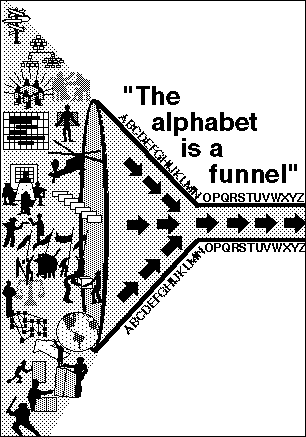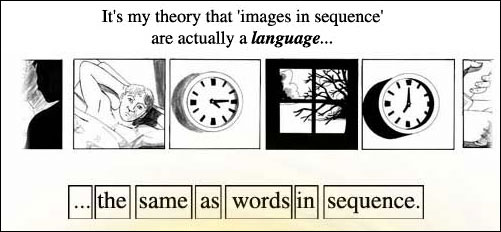« Urban Tribes: A scathing book review | Main | Are You The Crapkeeper? I am the Fluidmaster! »
September 28, 2003
Reading PIctures
So, in preparing for my keynote on modelling human behavior observed in research, I've taken a detour into the world of Visual Languages.
It began by looking up Tufte's Visual Explanations, and then trying to find texts related to it. Click through books under the subject "visual communication," I came across Visual Language, a book by Robert E. Horn. I've come across his stuff before, but never pursued it deeply. Now seemed the time.

The book is intriguing. Robert essentially lays out a deconstruction of visual language, beginning with the elements "words," "shapes", and "images," and then showing the various way these things can be cobbled together to communicate in a fashion richer than afforded with just one of the elements. The book is valuable for its breadth and depth alone -- a veritable catalog of ways that people have used visual language to communicate over the years. The book's single greatest disappointment is its ugliness -- the imagery too stark, the typography clumsy, the point often lost in hard-to-read graphics. This speaks to the fact that Horn seems to be most focused on a business audience -- the land of PowerPoint -- and so not as concerned with subtlety.
This business focus was disappointing... My cursory research leads me to suspect that the social sciences and humanities are *terrible* when it comes to utilizing visual language (with the occasional exception of statistics representations). I hope Horn's message is breaking beyond middle management and helping convince academia that the primacy of The Word above all else is shortsighted and foolish.
So today I've been wandering the Web, looking for more. I haven't found anything useful to my talk, but I've uncovered some keen items.

Emaki Productions is the web home of Neil Cohn, a decidedly precocious pup (he seems to have gotten his undergrad degree in 2002), who has written a fair amount about communicating visually. He seems to favor narrative and comics... Reading his site immedately calls Understanding Comics to mind.
![]()
The Visual Language Collection offers facet freaks a change to see an clever interface to a faceted classification collection. Unfortunately, the site isn't yet live.
Oh, and of course, there's Tufte's site. I don't need to mention that, do I?
And, um, that's it. I had trouble finding good stuff. Maybe you've got some pointers? It's interesting how poorly represented this field of visual language is, considering its prevalence and increasing importance. But I guess it's not "owned" by any one discipline, it's utilized across disciplines, and so there's no focused need for research and analysis.
Posted by peterme at September 28, 2003 07:13 PM
Trackback Pings
TrackBack URL for this entry:
http://www.peterme.com/mt/mt-tb.cgi/171
Listed below are links to weblogs that reference Reading PIctures:
» new favorite blog from Infomusings Blog
xBlog:The xBlog, ISSN 1543-7477, is a weblog that features design and visual thinking linking. xBlog is widely respected as a definitive resource for designers, visual storytellers and information architects. You'll find links to sites discussing visua... [Read More]
Tracked on October 12, 2003 05:04 PM
Comments
Academia isn't to blame for the primacy of The Word. That is predominantly a Western religious attitude (The Word=God) helped along by the learning-curve advantage (Latin/construction) which affords a measure of control (Marxist critique!).
Asian languages have always been pictorial.
And strictly speaking, people forget *words are images* (glyph-syllabary-letters) in sequence (a visual language). You look at words; they have shape.
The bigger advantage words offer is being both image and voice (ratio and sound). Pictures do not evoke *sounds* with their visual image. Words do that. Words have shape, rhythm, and style, being both image --and-- breathed breath of life (song + dance).
Posted by: Derek Rogerson at September 29, 2003 02:03 AM
I think Chris Ware's comic stuff (Jimmy Corrigan, Quimby the Mouse, Acme Novelty Library) is really a much better example of a visual language than McCloud's comic writings.
Posted by: Andrew at September 29, 2003 07:11 AM
Have you read Hoffman's _Visual Intelligence_ ?
Posted by: Abe at September 29, 2003 07:41 AM
Rudolf Arnheim has some older texts that are not super scientific in their methodology but very interesting; they consider a bunch of different examples of visual stimuli and how we react to them. Check out "Art and Visual Perception".
Also Josef Albers' text "The Interaction of Color" is a classic.
Posted by: Ethan Perry at September 29, 2003 02:23 PM
Kress and vanLeeuwen's Reading Images: The Grammar of Visual Design is one of the better academic studies of visual language I've come across. Also, my own study of visual languages in a digital media context, Seeing the Digital: Emerging Visual Literacies references a number of other worthwhile sources on the topic. (The study is a few years old now, but it does helpfully classify some basic structures of what might be called interactive visual rhetoric.)
Posted by: Greg at September 29, 2003 02:42 PM
Horn has also developed a writing technique called Information Mapping that looks like a good framework for developing and evaluating web content. It's backed by a fair amount of research (though most of it's from the print world).
The interesting thing is how well the Information Mapping theory and techniques matches the results of the Nielsen/Morkes study on how users' read on the web.
Posted by: Gene at October 1, 2003 11:17 AM
I found this article http://www.elearningpost.com/features/archives/002102.asp very useful.
Posted by: Xavier at October 1, 2003 09:01 PM
Peter,
do you know about that company called Xplane? http://xplane.com/company/
I learned about them recently while I was exploring the topic of visual thinking/visual languages (they've been in business for 5 or 8 years, I think). They maintain a visual thinking blog at http://xplane.com/xblog/
Recently I saw a great graphical representation in the NY Times (can't remember the date -- in the last 3 months, or so) of the various "nation building" efforts the U.S. has been involved in since WW II. It was done by a graphic design firm called the Chopping Block (http://www.choppingblock.com/). I'm not sure how much of this type of thing they do, though...
Michael Dashkin
PricewaterhouseCoopers
Posted by: Michael at October 2, 2003 10:53 AM
Understanding Comics - this is a great place to start...
http://www.amazon.com/exec/obidos/tg/detail/-/006097625X/102-9639184-1096169?v=glance
Posted by: Peter at October 12, 2003 09:13 PM
Dear Peter
A sequence of images is indeed a language, as any struggling delegate to a multinational conference will attest. I am a polyglot, practically born a foreigner, now working as a professor in fish biology and using at least 3 languages daily. I speak a few more and can be misunderstood in additional ones. Going past the stages of translating from one language to the other, thought may transform to be composed of a series of images or concepts to which words are subsequently attached (or garbled) according to audience. The images are clear, the words often deal with inherent subtleties, rhythms, dominance patterns, or other nuances. "Language is a virus" to quote an artist. The healthy image persists as an uberlanguage.
cheers
karin
Posted by: Karin Pittman at October 18, 2003 01:26 AM
I accidentally found this site but the comment about "images in sequence being a language" seemed familiar, considering a I work in a Infant/Toddler Preschool setting. It's all about images!
Posted by: Connie at November 7, 2003 10:02 AM
Hi,your homepage looks really good and gives great information!
Thank you very much!
Greetings from me!!
Posted by: Irene at November 23, 2004 02:02 AM
This whole visual language thing is fascinating (Though I am unclear how much of Horn's work is based on research in disciplines like psychology and linguistics as I've not had much time for independent research lately) but I would like to point out that some cultures are not visually orientated, hence VL could be seen as a form of cultural imperialism. I recall reading about a trib in South Amaerica or Africa that was Aurally oriented: to them a thing seen was not real until it was heard.
Someone pointed out that Asian languages always have been visual. This is not strictly true. As I recall Chinese allows a character to represent a sound as well as a concept: a bit like saying a picture of a Lion can represent the animal or the concept of Lion about doing nothing. Japanese is like Chinese in many ways but Thai, Burmese - uncannily like the Georgian Alphabet - and the pre-spanish scripts of the Philippines were and are well away from the visual.
Which brings me to our alphabet. As I understand it the consensus is that the characters of the alphabet had pictorial origins.
So what we have is a progression from picture to sound (Syllabary for example) to a true alphabet. with VL taking thongs back to the starting point.
One problem with Visual Language as I see it is that it could be too academic. We will have a real Visual Language when we have visual slang. Perhaps we should look to Media Studies to see how a Visual language might evolve rather than being designed. There have been too many artifical languages designed int he past and all have failed. Yes that includes Esperanto in my view.
Another problem is the difficulty of standardising image meanings and connotations. Religion is especially sensitive in this field. Just look at some images ( including those here) and think how they would be "Read" by a Muslim, Jew, Indian or African. Or homelss or disabled people. In fact I feel standardising the meanings removes a whole dimension of meaning from a sequnece of images
Posted by: alex Kashko at November 8, 2005 07:14 AM